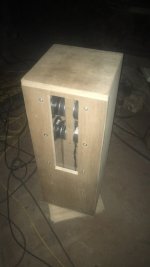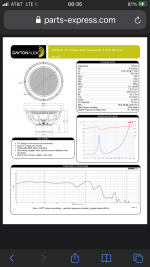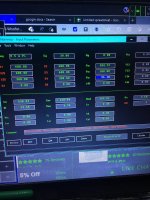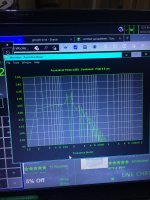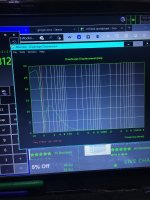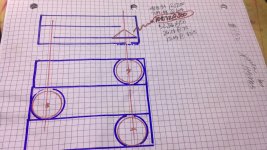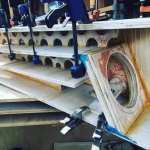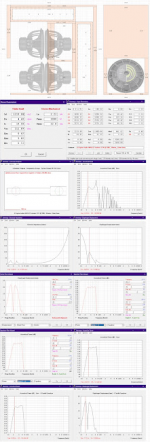try a reduction at the second green line not a taper much mo
Well you should probably try to incorporate the harmonics and listen to them side-by-side with a random fold/enter TL that doesn’t have any rhyme or reason to it and it’s a different bird.A TL is just an alternative BR in my book.
BP's 4 life!
Mr. Steele doesn’t seem to understand this concept
I’d like to explore more BP action myself but in qw configurations(pic is a screamer with 4 , 4” drivers
Attachments
I've been modeling a few TQWP/TQWT's (Tapped Quarter Wave Pipe/Tube) the past week. I just love simplicity of not dealing with any angles. A couple of them turned out to be stepped TH's because of the isobaric configuration.



I've been modeling a few TQWP/TQWT's (Tapped Quarter Wave Pipe/Tube) the past week. I just love simplicity of not dealing with any angles. A couple of them turned out to be stepped TH's because of the isobaric configuration.
This is a breath of fresh airI've been modeling a few TQWP/TQWT's (Tapped Quarter Wave Pipe/Tube) the past week. I just love simplicity of not dealing with any angles. A couple of them turned out to be stepped TH's because of the isobaric configuration.
a little odmltl for you(pi/9)
(oops. 0.5xpi from
the corner loaded version earlier
(oops. 0.5xpi from
the corner loaded version earlier
Attachments
Hi Brian
I am helping a friend with a Tapped Horn design. I promised him something simple to build. Could you please add this design to our spreadsheets?

I am helping a friend with a Tapped Horn design. I promised him something simple to build. Could you please add this design to our spreadsheets?
Another friend wants help simulating a backloaded horn. I found this interesting paper by King, containing two simple to build compact back loaded horns. Please consider including them in box plans. http://quarter-wave.com/Horns/BLH_Design_Article.pdf
I am working on a Cubo design and I noticed that the Atc is automatically calculated. Can someone tell me what paramaters are used for that cell? The formula shows =Panels!T77 but I can't even find a hidden cell that would match that criteria unless there is a hidden tab or something,,admittedly it's been a while since I did anything advanced with excel lol. Thanks!
It's on a hidden sheet called "Panels" You should be able to unhide the sheet as nothing in the workbook is password-protected. cell protection is on and some sheets are hidden primarily to ensure that the user doesn't screw up any of the calculations, but if you know what you're doing and aren't afraid to make some changes, feel free to go ahead and make them.
Thanks Brian! Thankfully I didn't need to change anything. I just wanted to see how that cell was calculated and now I have a whole new appreciation for how complicated these spreadsheets are! Wow! I moved to databases when I left accounting many years ago. I could see writing this in SQL but to put all this into separate sheets with associated formulae and keep track of it must have been one hell of a project. My hat's all the way off to you man. Monumental effort here! ...again, Thanks for all the hard work!It's on a hidden sheet called "Panels" You should be able to unhide the sheet as nothing in the workbook is password-protected. cell protection is on and some sheets are hidden primarily to ensure that the user doesn't screw up any of the calculations, but if you know what you're doing and aren't afraid to make some changes, feel free to go ahead and make them.
Hey everyone I need help braking down this formula.
Section 7.0 : Design of a Back Loaded Exponential Horn By Martin J. King, 7/01/08
Copyright © 2008 by Martin J. King. All Rights Reserved.
the generic driver, and the exponential horn geometry, to study the changes that occur in the calculated responses.
Baseline Exponential Horn Design :
The first simulation to be run, and results presented, will be referred to as the baseline design. The lower cut-off frequency fc is specified as 50 Hz to match the driver’s fd. A coupling chamber will not be included in the baseline horn geometry. The throat area is set equal to the driver’s Sd so that a length can be calculated. This is a consistent back loaded horn design.
To start the design process, the area of the horn mouth is calculated using Equation (5.3).
Smouth =(1/π)x(c/(2xfc))2
Smouth =(1/π)x(342m/sec/(2x50Hz))2 Smouth = 3.723 m2 = 5771 in2
Smouth = 181.6 x Sd
Using Equation (5.2), the flare constant is calculated next. m = (4 π fc) / c
m = (4 π 50 Hz) / 342 m/sec
m = 1.837 m-1
And finally, the horn’s length is calculated using Equation (5.1) after setting the throat area equal to Sd.
Lhorn = ln(Smouth / Sthroat) / m Lhorn = ln(181.6 / 1) / 1.837 m-1 Lhorn = 2.831 m = 111.5 in
Section 7.0 : Design of a Back Loaded Exponential Horn By Martin J. King, 7/01/08
Copyright © 2008 by Martin J. King. All Rights Reserved.
the generic driver, and the exponential horn geometry, to study the changes that occur in the calculated responses.
Baseline Exponential Horn Design :
The first simulation to be run, and results presented, will be referred to as the baseline design. The lower cut-off frequency fc is specified as 50 Hz to match the driver’s fd. A coupling chamber will not be included in the baseline horn geometry. The throat area is set equal to the driver’s Sd so that a length can be calculated. This is a consistent back loaded horn design.
To start the design process, the area of the horn mouth is calculated using Equation (5.3).
Smouth =(1/π)x(c/(2xfc))2
Smouth =(1/π)x(342m/sec/(2x50Hz))2 Smouth = 3.723 m2 = 5771 in2
Smouth = 181.6 x Sd
Using Equation (5.2), the flare constant is calculated next. m = (4 π fc) / c
m = (4 π 50 Hz) / 342 m/sec
m = 1.837 m-1
And finally, the horn’s length is calculated using Equation (5.1) after setting the throat area equal to Sd.
Lhorn = ln(Smouth / Sthroat) / m Lhorn = ln(181.6 / 1) / 1.837 m-1 Lhorn = 2.831 m = 111.5 in
Well, are you truly going to build an exponential rear load horn enclosure?
WE normally build parabolic enclosures...2 parallel sides with the top and bottom pieces expanding in height.
Exponential horns have ALL sides expanding in width and height.
WE normally build parabolic enclosures...2 parallel sides with the top and bottom pieces expanding in height.
Exponential horns have ALL sides expanding in width and height.
Well I trying to build super scoops but want to build them the drivers I am about to purchase. And I thought that was a generic formula for rear loaded horns.Well, are you truly going to build an exponential rear load horn enclosure?
WE normally build parabolic enclosures...2 parallel sides with the top and bottom pieces expanding in height.
Exponential horns have ALL sides expanding in width and height.
Ok so my question is how can I configure these plans to a particular driverThese are quite popular: http://hornplans.free.fr/hogscoop.html
- Home
- Loudspeakers
- Subwoofers
- Spreadsheet for Folded Horn Layouts...
